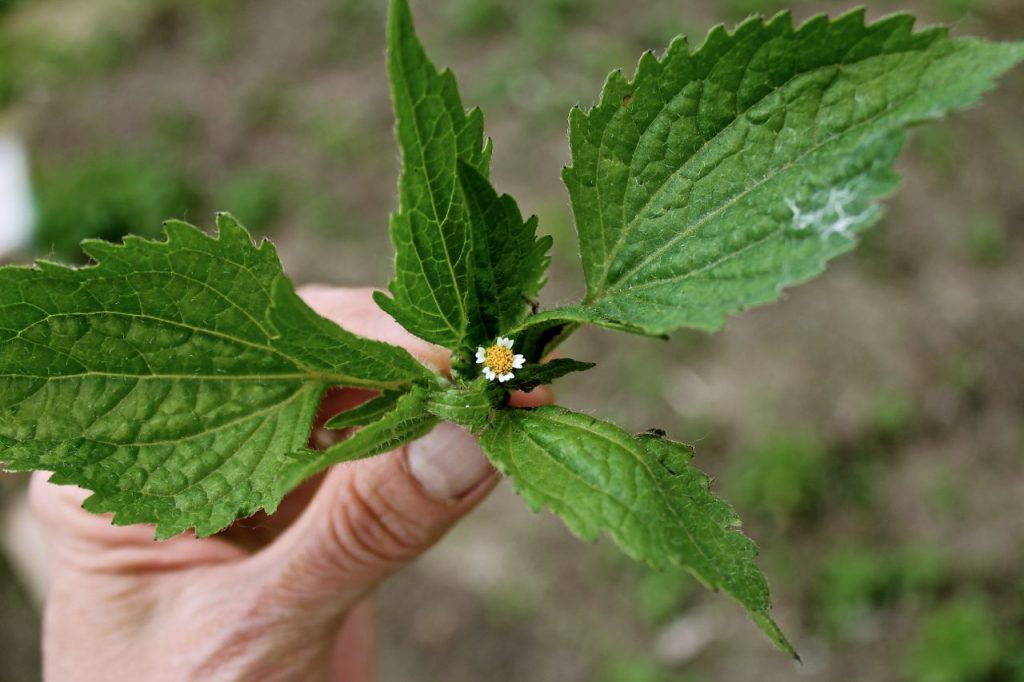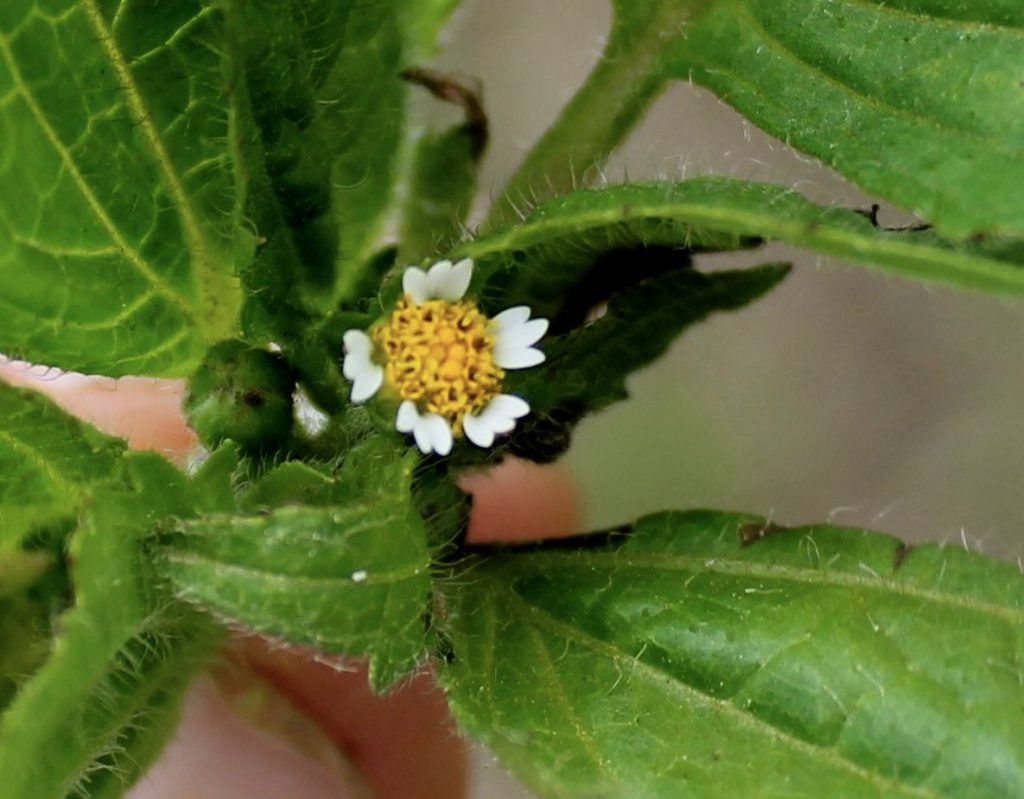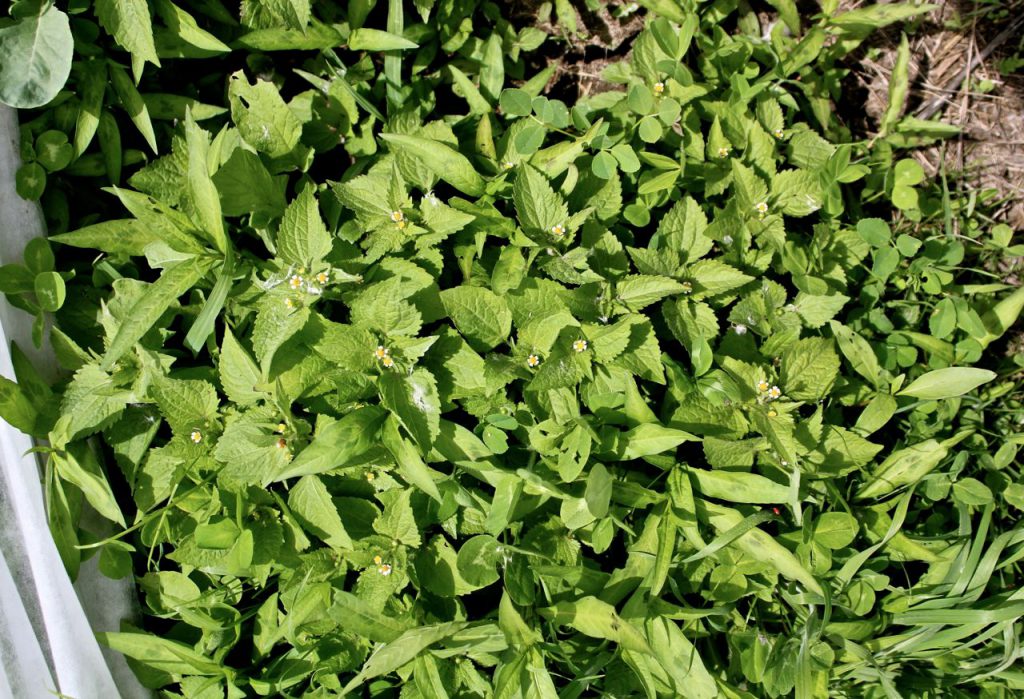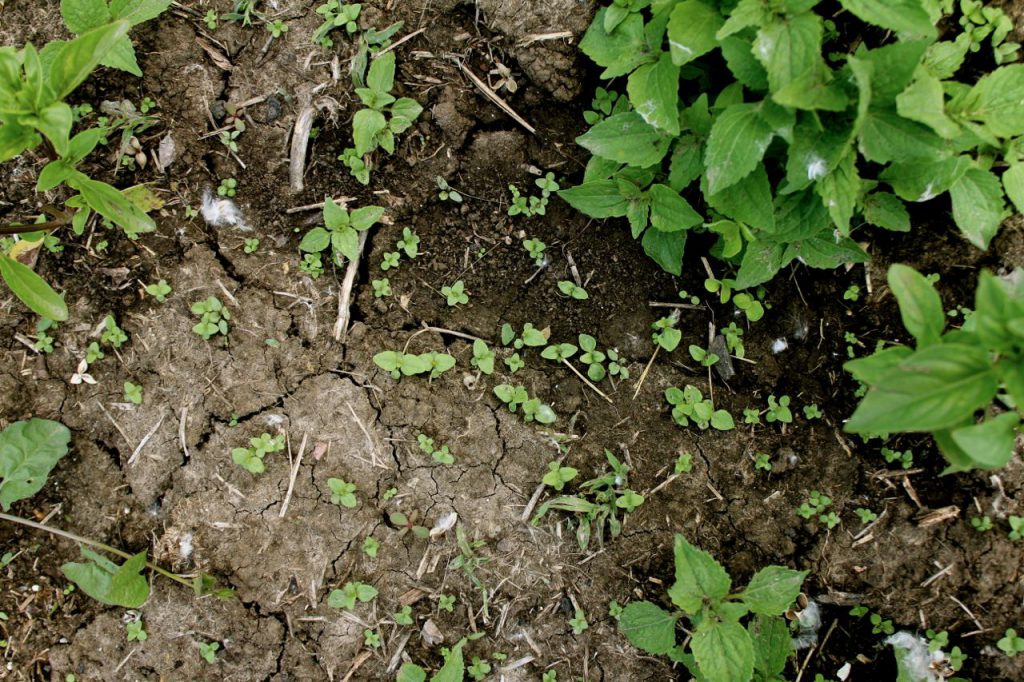Hairy Galinsoga: this new weed will not break me . . .
But, by golly, it has tried its best to do so!

One really great thing about gardening is that you learn something new every season. Usually several somethings-new.
I learned about a new weed this week.
Probably there is a study someplace that shows that avid gardeners have lower incidences of brain decline, because we are always, always trying to solve problems! Really!! Just this spring, I’ve had to puzzle, sweat over, and ponder the following:
-
- Question: What keeps getting my tomato plants all curly and depressed? Likely answer: neighbors’ 2,4D drift. 🙁 (More about this later.)
- Question: What do I do with hail-damaged rhubarb plants? Answer: harvest and make pie!
- Question: I have three new apple trees that followed me home from the store and my orchard is full, full, full! Where should I plant them? Answer: Expand the orchard, silly-pants. DO WHAT YOU MUST TO HAVE FRUIT.
- Question: I’m reclaiming my third garden, which has been heretofore The Most Lush Weed Resort, and making it into both a berry bramble, and a melon and pumpkin patch. How to do this sans rototiller (which happens to be in the shop, forever, it appears)? Answer: Cover the space–weeds and all, tra-la!–with landscape fabric, cut holes in it and plant in them. Quite possibly the crudest garden hack I’ve ever done, but it seems to be working! The fabric–ideally!–smothers the weeds. Naturally I ran soaker hoses underneath to make watering easier. My plants, so far–though they are probably bewildered–are still alive.
- Question: My garden is full, full, full and I still have a bulging flat of baby leeks to plant, not to mention more peppers, melons, and squash. What to do?? Answer: haven’t figured this one out yet.
Here’s the thing.
You may think that you’ve figured out how to grow potatoes, spinach or squash, and then something new happens! And you have to puzzle it out for yourself, because the environment is changing all the time and is it your fault that it slaps you upside the head again and again?
No, gentle reader, it’s not. Nothing is ever your fault. You are conscientious to a fault, and you do everything right. Or at least you certainly try to.
Case in point: last year, the Harlequin Bug showed up for the first time and stripped all my brassicas overnight, to my astonishment! Worse yet, the chickens wouldn’t even eat the hard-shelled, flamboyantly-colored bug.
And now, getting the blessed point of this post:
This year: a brand new weed showed up in my garden, blanketing every bed like, well, like a blanket (and no, it’s not blanket weed).
Weeds happen, you know? Thanks to Adam and Eve, there will always be weeds. But this weed. This weed. It’s a baddie, so I’m sharing with my favorite people in the universe (you guys) what I’ve learned about it, so you can be on the lookout for it. So when it shows up in your garden, you’ll know what to do.
First, a bit of backstory:
I felt a sense of foreboding very early this spring, when I spotted the miniscule leaves, clustered so closely together, coming up in my garden. They were impressive in their tiny-ness, in their sheer numbers (i.e. lots and lots) and in their pervasiveness. They seemed to be coming up everywhere. I had never seen anything like this before.
It gave me the same feeling that I have when I see baby grasshoppers be-bopping among the lettuces. “This is bad,” think I, “but it’s going to get lots worse.”
The little weeds grew very quickly. I had planted several beds with cool-weather-loving crops: beets, spinach, radishes, kohlrabis, carrots. These tiny leaves would pop up and fill in the beds within days of my planting them. My poor spinach, beets, radishes, etc. didn’t stand a chance. The weeds grew so quickly and filled in the beds so thoroughly, before the veg seeds could even germinate!
When I wasn’t pulling weeds, I spent spare moments searching through Mack’s book on Nebraska Weeds, and thumbing through websites, looking for information on what fresh new hell this weed was. Other gardeners that I talked with didn’t seem to know what weed I was talking about.
Here it is.
It looks so innocuous, really. Pretty, soft green leaves, a little bit hairy, with a tiny flower in the middle. Sweet. Right?

The flower is so tiny that my camera had trouble focusing on it.
In fact, after listening to me grumble about this mysterious new weed-from-hell, Mack jumped in to the identification process. Any sort of research, he absolutely adores. Especially if it gets him out of hauling mulch or pulling weeds. Yesterday morning, Mack came running out to the garden, yelling. “Mom! I found a website! Come see! You will be able to figure out what that weed was, I’m sure of it!”
I had been pulling the awful little weeds for a couple of hours by this time, and I was trying to re-plant a bed that was a total loss. I was hot and sweaty, and had been interrupted several times already in just the last hour or two. “Not now,” I mumbled. “I’ll come in later and take a look!”
“Later” happened to be bedtime that night, when I pulled open my laptop to jot something down for the next day. The website that Mack had found was still standing open. It took me five minutes to type in the pertinent information–compound leaves or simple? Petioles or no? Hairy leaves or smooth? etc., and the little devil-weed was identified.
Moreover, now that I have a name for it, it was very easy to find more information about it. This weed, indeed, is a formidable foe to gardeners. The more information you possess, the easier it is to come up with a suitable strategy to annihilate the suckers.

Thank you to Wikipedia for this macro shot.
So this is the weed name that you must remember, if you are an avid gardener. Because if you let this weed run rampant over your garden, it can cut your production by at least 50%. It will cause you, also, to rant and rave, stamp your feet and cry, and pull out your hair in large chunks. Honest.
hairy galinsoga
hairygalinsogahairygalinsogahairygalinsogahairygalinsogahairygalinsogahairygalinsogahairygalinsogahairygalinsogahairygalinsoga
*Hairy Galinsoga, ya’all* H∀IRY GALINS∅G∀
Galinsoga quadriradiata
Here are the facts about this weed. If you have it, you know it. If you don’t have it, you’re lucky.
- Hairy galinsoga is an annual weed that produces many small flower heads, each about a quarter of an inch wide. They are cute as the proverbial button! The flower heads are composite, meaning they are made up many individual flowers, each of which produces seed. The flowers are white on the edges and yellow in the center. If you roll some of the flowers between your fingers you may be surprised to find that the small black seeds have already formed, even though the flower doesn’t look like it has matured to that point. Amazing!
- Galinsoga makes seeds whenever it can. A single plant can produce up to 7,500 seeds, and mature seeds can be formed in as little as 6 weeks. Therefore: a single plant that you miss in your weeding regimen can lead to a serious infestation. Galinsoga is the fertile bunny of the weed world.
- Hairy galinsoga spreads quickly via moving of soil amendments, cultivation, field equipment and anything else that moves soil. Galinsoga is one of the most difficult to control weeds.
- Left uncontrolled, Galinsoga can spread quickly, often dominating an entire field, like some kind of evil cover crop run amok. It begins to flower and produce seed when it has just five or six pairs of leaves, and it continues until it’s killed by a frost. Fresh seed drops onto the soil surface and soon sprouts because there is little or no dormancy. The new seedlings repeat the cycle.

This is my kohlrabi bed. See any kohlrabi? Me neither. Only Hairy Galinsoga.
- If you don’t have it, don’t get it. Be careful of anything you bring onto your place. Do germination tests on manure, compost, potting soil, etc. Don’t pick up mulch from others unless you know that they aren’t infested. A few bags of leaves or grass clippings just ain’t worth it, folks. And that comes from the biggest mulch-scrounger in the area (that is to say, me).
- When you see galinsoga in one area, take the time to rid the area of it entirely. And don’t just pull the weeds and drop them: more than likely they will just re-root themselves. Haul them away from the garden in a bucket and burn or destroy. I wouldn’t feed them to your chooks, either, since they will likely just plant them later. 😉
- Try not to spread it: This weed spreads rapidly by bits of the weeds and/or seeds clinging to dirt on garden tools, rototillers, work boots, etc. So if you have one area that is infested, try not to move it around as you are working on it. It may be a pain to power-spray your tools before using them in another area of your place, but–trust me–it’s nothing compared to fighting this weed. I personally have it in only one area of my place–the first garden–and I’m doing everything I can to avoid spreading it to other garden areas.
- Use heavy mulch and cover crops. I am piling heavy mulch any place that I see these little weeds coming up. And I’m planning to plant a thick cover crop this fall, which ought to help smother it. Hopefully.
My strategies so far in fighting this weed:
- Water and pull: Galinsoga likes to snap off in your hands when you try to pull it. But if you soak the area first, it will likely come up with the roots. And you want those roots, baby.
- Use heavy mulch to smother: After I clean up an area of galinsoga, this is what I find underneath:

Baby galinsoga! Yikes!


Gee what we might call a weed, such as Tansy and not sure if Nebraska have them. Actual some place wouldn’t call them a weed. They help keep down the aphids
Coffee is on
I don’t have Tansy in my garden, but I know that my MOm does. I think it is pretty invasive here.
Wow! Not sure we have that in uk… At least not in my garden thankfully. ( dandelions, yes, but I’m embracing that since I learnt how to make dandelion honey!)
It’d be interesting to see if you have an issue in the new bed where you laid the fabric and planted thru.
We garden similar to ‘back to eden’ method and it helps so much with weed control.
Maybe this is a message to try another method… These things are sent to try us for a reason!
I agree, Ali. Next year I probably won’t (at least) rototill the first garden up again (that’s where this weed showed up). I’ll let the sleeping seeds lie, for sure.
Yikes!!! I feel like I just read the Alfred Hitchcock’s ” Birds” version of a blog post on this prolific little devil!!!!! Going out to check the gardens now!!!
Jo, I really want to hear about it if you found some in your garden! I found a little patch near my chicken coop this morning and pulled and pulled until it was gone!
At least you don’t have mile a minute weed. We don’t, either. Yet.
We don’t have weeds, we have green trees, which can make them easier to pull when we get to the area. Once we weed, it seems to mean a new toilet area for the dogs, which keeps me busy on a daily basis. Because of the dogs, I sometimes look at the weeds as a blessing and leave them until it becomes a mini-project. Please keep your galinsoga up North. I think we have enough different weeds to keep us busy as it is…
We always had those weeds in my mom’s garden in WV. I have even read that it is edible.
And I thought bindweed was bad.
I have been fighting this weed for several years now, and I have just discovered what it is called. I live in Northern Ontario Canada. I think I got it from a load of manure from a farmer. Thanks for the advise, I will continue my battle with this monster.
Edith, I plan to do a follow-up post very soon. I’ve nearly eradicated it from my place in one season–but it hasn’t been easy. It’s very important to get it as quickly as possible!!
Hairy galinsoga is actually a delicious edible, closely related to a highly-sought-after plant called guascas that is part of the traditional cuisine of Bogotá, Colombia. As a “weed,” it likely packs more nutrition than any cultivated greens. (http://www.eattheweeds.com/galinsoga-ciliata-quickweed-is-fast-food-2/#:~:text=The%20entire%20plant%20is%20eaten,plant%20it%20has%20great%20taste.&text=Nutritionally%20the%20leaves%20of%20the,carbs%205.2g%2C%20fiber%201.1.)
I both cultivate greens and harvest and eat the “weeds” – just a thought, if you’ve still got some left in your garden.
Also, just found your blog and am really enjoying your writing style. 🙂
Anna, I so appreciate your comment. I realize that it is nutritious and the irony that I’m pulling it and tossing it away, when it’s more nutritious than a lot of the crops I’m making room for–is not lost on me! I wish I could grow both, but it is so amazing in its growth habit, I’m afraid I’d never be able to keep it from invading all my other beds! But I’ll give this some thought–maybe I could grow it like other invasive plants (mint?), in a barrel? And YES I do still have it in my garden. Probably I will until kingdom come.
Thanks for meeting my need to scream as I have just identified this little pest! With difficulty. Do I want to dry the leaves and eat it too? Probably not… so it’s back to finding a selective tee jet nozzle for my glyphosate, because I need reinforcements for my aching back!
Ha! Good luck! After all these years (I wrote that post several years ago) of fighting it, I still find it springing up in random places. I never resorted to RoundUP but learned a lot of tricks for how to rid our property of it.